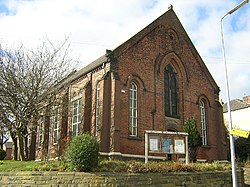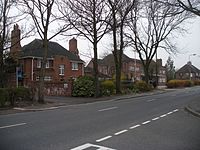Boothstown
- Not to be confused with Boothtown
| Boothstown | |
| Lancashire | |
|---|---|
 Methodist Chapel, Boothstown | |
| Location | |
| Grid reference: | SD718007 |
| Location: | 53°30’9"N, 2°25’31"W |
| Data | |
| Population: | 9,599 (2011, with Ellenbrook) |
| Post town: | Manchester |
| Postcode: | M28 |
| Dialling code: | 0161 |
| Local Government | |
| Council: | Salford |
| Parliamentary constituency: |
Worsley and Eccles South |
Boothstown is a suburban village in the townscape of Salford in the south of Lancashire. It is five miles to the north-west of Salford itself, bordered to the north by the East Lancashire Road A580 and to the south by the Bridgewater Canal. Historically, it was a hamlet partly in Worsley township in the parish of Eccles, and partly in Tyldesley in the parish of Leigh.[1]
The village is seven miles north-west of Manchester and ten miles south-east of Wigan. Once known for its mining community, Boothstown is now a mainly residential area.
Contents
History
Evidence of the Romans in this area is that in 1947, workmen digging in Boothstown at SD72160108 discovered a hoard of over 550 bronze Roman coins dating between 259 AD and 278 AD.[2] A second hoard of coins dated 289 - 296 A.D. was found at Boothsbank in 1989.[3]
Manor
In 1323 the estate or manor of Booths was held by the de Worsley family and remained with that family, held of the king by a rent of 2s, until the reign of Elizabeth I. In the 17th century the manor was held by Charnock and then by Sherington. Booths Old Hall was built about 1343 and New Booths Hall was built in the early-17th century.[3] The hearth-tax returns of 1666 show nearby Wardley Hall was the largest residence with 19 hearths, Worsley Hall and Booths had 17 each. There were 276 hearths in the township, Worsley proper had 191. The house, in the latter part of the 18th century, was owned by the Clowes family who owned Garrett Hall in neighbouring Tyldesley.[4][5] Lord Francis Egerton bought the estate from Robert Haldane Bradshaw in 1836 and Booths and became part of the Manor of Worsley.[3]
Industrial Revolution
In 1795 the Bridgewater Canal was extended from Worsley, through Boothstown to Leigh. The growth of Boothstown was based on coal and cotton. Cookes Meadow Pit at Ellenbrook dated from 1760-70 but deep mining came with the sinking of Mosley Common Colliery in the 1860s. An early colliery tramway moved coal from the pits at Ellenbrook down to the canal at Boothstown Basin by gravity, using the slope of the land.[3]
Boothstown's underground canal, the Chaddock Level, was used to transport coal during the 19th century. It connected the Bridgewater Canal at a small basin approximately 100 yards east of Moss House Lane to Chaddock Colliery, the Queen Anne Pit (1810 to 1820) and Henfold Pit in Tyldesley. The keystone on the entrance to the Chaddock Level is dated 1816. The pits on the Tyldesley side of Boothstown had closed by 1870.
In 1931 Boothstown Mines Rescue Station was built along with housing for the rescue team members and other staff, it is a Grade II Listed building.[6][7]
A Mr Smith built a small cotton mill in Boothstown Delph by the Stirrup Brook in 1812.[3] In 1891 Edward Makin of Garden Mill had 260 looms weaving "regattas, stripes, ginghams etc." and William Yates' Boothstown Mill had 9,000 spindles and 242 looms producing fine quality cotton from 1875 until the mill closed in 1968.[8]
Modern history
The M60 motorway was constructed to the east of Boothstown in the 1970s (originally as the M62). The Royal Horticultural Society opened a national garden at Bridgewater in 2021.
Outside links
References
- ↑ Boothstown, Genuki, http://www.genuki.org.uk/big/eng/LAN/Worsley/ParishMap.shtml, retrieved 17 January 2010
- ↑ National Monuments Record: No. 44272 – @
- ↑ 3.0 3.1 3.2 3.3 3.4 Boothstown, visitsalford, http://www.visitsalford.info/boothstown.htm, retrieved 14 December 2008
- ↑ A History of the County of Lancaster - Volume 4 pp 376–392: @ (Victoria County History)
- ↑ Boothstown, genuki.org.uk, http://www.genuki.org.uk/big/eng/LAN/Boothstown/, retrieved 2009-12-11
- ↑ Boothstown Mines Rescue, colsal.org.uk, http://www.colsal.org.uk/sites/lancashireminesrescue/Homepage.asp, retrieved 14 December 2008
- ↑ National Heritage List 1228029: Boothstown Lancashire Mines Rescue Station (Grade II listing)
- ↑ Cotton Mills in Boothstown, gracesguide.co.uk, http://www.gracesguide.co.uk/wiki/Cotton_Mills_in_Manchester_and_Salford_1891#Boothstown._6_miles_N.N.W._from_Manchester_.28p129.29, retrieved 14 December 2008
- Crawford, Elizabeth (2003), The Women's Suffrage Movement: A Reference Guide 1866-1928, Routledge, ISBN 1-135-43402-6
